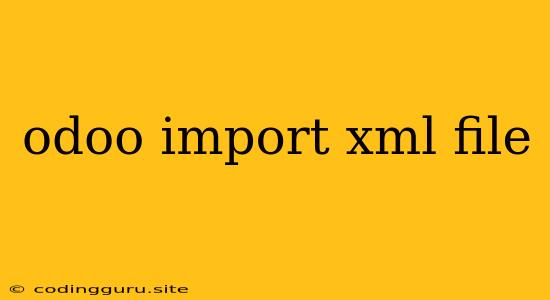Importing XML Files into Odoo: A Comprehensive Guide
Odoo is a powerful and versatile open-source ERP system that allows businesses to manage various aspects of their operations, from accounting and sales to inventory and manufacturing. One of the key features of Odoo is its ability to import data from external sources, including XML files. Importing XML files into Odoo can be a valuable tool for a variety of tasks, such as:
- Migrating data from legacy systems: You can import data from old systems into Odoo to ensure a smooth transition.
- Populating initial data: You can import data to create a starting point for your Odoo database, such as product information, customer data, or supplier details.
- Importing large volumes of data: Importing data in bulk from XML files is often more efficient than manually entering data.
- Regularly updating data: You can import data from external sources on a regular basis to keep your Odoo database up-to-date.
This guide will provide a comprehensive understanding of how to import XML files into Odoo, covering key aspects like:
1. Understanding XML and Odoo's Data Structure
Before delving into the specifics of importing XML files, it's essential to grasp the fundamental concepts of XML and Odoo's data structure.
- XML (Extensible Markup Language): This is a standardized format for representing data. It uses tags to define elements and attributes to store data within those elements. This structure makes XML data easily readable and interpretable by machines.
- Odoo Data Structure: Odoo uses a relational database to store data. Data is organized into tables, with each table representing a specific type of data (e.g., products, customers, orders).
2. Preparing your XML file for Odoo Import
Before you can import your XML file into Odoo, you need to ensure it's formatted in a way that Odoo can understand. Here are key steps:
- Define the root element: The XML file needs a root element that represents the overall data structure.
- Use appropriate tags and attributes: The tags and attributes in your XML file should correspond to the data fields defined in Odoo's database tables.
- Structure your data correctly: The data within the XML file should be organized logically and reflect the relationships between different types of data.
3. Importing XML Data into Odoo: Methods and Tools
Odoo offers various methods and tools to import data from XML files. Here are the most common approaches:
- Direct Upload: Odoo's interface allows you to directly upload an XML file into your database. This method is suitable for small to medium-sized data imports.
- The 'Import' Menu: Navigate to the relevant Odoo module (e.g., 'Products', 'Customers') and look for an 'Import' option. This option typically provides a wizard that guides you through the import process.
- Using Odoo's Python API: For more complex imports or customization, you can leverage Odoo's Python API. This allows you to write scripts that interact with the Odoo database and import data programmatically.
- Third-Party Tools: Several third-party tools, such as OpenERP Studio or Odoo Studio, can simplify the import process. They provide visual interfaces for defining the mapping between your XML file and Odoo's data structure.
4. Tips for Successful XML Data Import
Here are some essential tips to ensure a smooth and successful import:
- Validate your XML file: Use an XML validator to check for syntax errors and ensure the file is well-formed.
- Test your import with a sample file: Import a small sample of your data to test the mapping and ensure it's working as expected.
- Create a backup: Always create a backup of your Odoo database before importing large amounts of data.
- Check for data duplicates: Make sure your XML data doesn't contain duplicate entries that could cause conflicts in your database.
- Use the Odoo Documentation: The official Odoo documentation provides detailed information about importing data, including specific instructions for various modules and data types.
5. Examples: Importing Products and Customers into Odoo
Let's illustrate the process with two examples:
a) Importing Product Data:
Product A
100
80
product
Product B
150
120
product
This XML snippet defines two products, "Product A" and "Product B," with their respective names, list prices, standard prices, and types.
b) Importing Customer Data:
Customer A
[email protected]
1234567890
True
Customer B
[email protected]
9876543210
True
This XML snippet defines two customers, "Customer A" and "Customer B," with their names, email addresses, phone numbers, and customer status.
6. Conclusion
Importing XML files into Odoo can streamline data management and improve efficiency. By understanding the basics of XML, Odoo's data structure, and utilizing the available import tools, you can successfully import data into your Odoo database and leverage the full potential of this powerful ERP system.
Remember: Always test your imports on a sample data set before importing large volumes of data and take advantage of Odoo's documentation for specific instructions and guidance.
